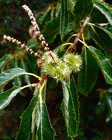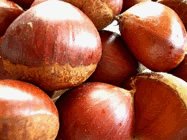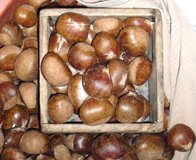Chestnuts Nutrition facts
Starchy, sweet, rich in flavor, chestnuts are popular edible nuts of the northern hemisphere origin. The nuts are native to the mountainous forests of China, Japan, Europe, and North America.
Botanically, they belong to the beech or Fagaceae family, in the genus: Castanea. Scientific name: Castanea sativa (Sweet chestnuts)
Castanea species are large deciduous trees. They are monoecious; bearing both male and female flowers (“catkins”) on the same tree. They have a remarkable survival history to narrate. Early in the 20th century, the mighty American chestnut tree was almost wiped out by pathogenic fungus chestnut blight (Cryphonectria parasitica). A renewed interest has been growing since then to revive native chestnut trees throughout the US.

|

|
| Castanea sativa. Note for flowers (catkins) with immature fruits (burrs). Courtesy: selkovjr | Chestnuts-Japanese variety, (C. crenata). Courtesy: kanko |
Once pollinated, female flowers develop into large spiny burrs or involucres, each enclosing about 2-3 edible kernels. The fruit is quite larger compared to other tree nuts like cashews, macadamia, etc. Each nut features a smooth, glossy, dark-brown outer shell, 1-1.5 inches in diameter and weighing 8-12 g depending upon the species. Inside, its sweet and starchy kernel features outer brown but inner creamy white flesh.
Four main species of chestnut trees cultivated around the world for their nuts; Castanea sativa in Europe, C. dentata in North America, C.mollissima in China and C. crenata in Japan. The United States is the chief importer of chestnuts from the European Union, although China has been the largest exporter of nuts worldwide, especially to Japan.
Health benefits of Chestnuts
Chestnuts, unlike other nuts and seeds, are relatively low in calories and fats. Nonetheless, they are rich sources of minerals, vitamins, and phytonutrients that immensely benefit health.
Another unique feature of chestnuts is that they are primarily composed of starch (carbohydrates) in contrast to other kinds of tree seeds and nuts which are rather high in calories, protein, and fat. Chestnuts nutrition composition is, therefore, comparable to that of other staple starch foods such as sweet potato, sweet corn, potatoes, plantain. Nevertheless, they are still good sources of minerals, vitamins, and some good-quality protein than cereals and tubers.
They are an excellent source of dietary fiber; provide 8.1 g (about 21% of RDI) per 100 g. A fiber diet helps lower blood cholesterol levels by limiting excess cholesterol absorption in the intestines.
Chestnuts stand out from other edible nuts for their distinctive nutrition profile. They are exceptionally rich in vitamin C . 100 g nuts provide 43 mg of vitamin C (72 % of DRI). Vitamin C is required for matrix formation in teeth, bones, and blood vessels. Being a strong antioxidant, it offers protection from harmful free radicals.
Again, chestnuts are rich in folates akin to green leafy vegetables, which is quite a rare but unique feature for nuts and seeds. 100 g nuts provide 62 µg of folates (or 15.5%). Folic acid is essential for the formation of red blood cells, and DNA synthesis. Adequate consumption of food rich in folates during the peri-conception period helps prevent neural tube defects in the newborn.
Like true nuts, they too are a rich source of mono-unsaturated fatty acids like oleic acid (18:1) and palmitoleic acids (16:1). Studies suggest that monounsaturated fats (MUFs) in the diet help lower total as well as LDL (bad cholesterol) and increase HDL (good cholesterol) levels within the blood. Mediterranean diet which is rich in dietary fiber, MUFs, omega fatty acids, and antioxidants helps prevent coronary artery disease and strokes by favoring a healthy blood lipid profile.
The nuts are an excellent source of minerals such as iron, calcium, magnesium, manganese, phosphorus, and zinc, besides providing a very good amount of potassium (518 mg / 100 g). Potassium counters the hypertensive action of sodium and thereby, lessens heart rate and blood pressure. Iron helps prevent microcytic anemia. Magnesium and phosphorus are essential components of bone metabolism.
Further, they are also rich in many important B-complex groups of vitamins. 100 g of nuts provide 11% of niacin, 29% of pyridoxine (vitamin B-6), 100% of thiamin, and 12% of riboflavin.
Chestnuts, just like hazelnuts and almonds, etc., are gluten free food items. Moreover, for the same reason, they are one of the popular ingredients in the preparation of gluten-free food formulas intended for use in gluten-sensitive, wheat allergy, and celiac disease patients.
Chinese chestnuts (C. mollissima) are good in vitamin A; provide 202 IU per 100 g.
| Principle | Nutrient Value | Percent of RDA |
|---|---|---|
| Energy | 213 Kcal | 11% |
| Carbohydrates | 45.54 g | 35% |
| Protein | 2.42 g | 4% |
| Total Fat | 2.26 g | 10% |
| Cholesterol | 0 mg | 0% |
| Dietary Fiber | 8.1 g | 21% |
| Vitamins | ||
| Folates | 62 µg | 15.5% |
| Niacin | 1.179 mg | 7% |
| Pantothenic acid | 0.509 mg | 11% |
| Pyridoxine | 0.376 mg | 29% |
| Riboflavin | 0.168 mg | 13% |
| Thiamin | 0.238 mg | 20% |
| Vitamin A | 28 IU | 1% |
| Vitamin C | 43 mg | 72% |
| Electrolytes | ||
| Sodium | 3 mg | 0% |
| Potassium | 518 mg | 11% |
| Minerals | ||
| Calcium | 27 mg | 3% |
| Copper | 0.447 mg | 50% |
| Iron | 1.01 mg | 13% |
| Magnesium | 32 mg | 8% |
| Manganese | 0.952 mg | 41% |
| Phosphorus | 93 mg | 19% |
| Zinc | 0.52 mg | 5% |
| Phyto-nutrients | ||
| Phyto-sterols | 22 µg | -- |
Selection and storage

|
| Chestnuts in a market. |
Chestnuts are a cool season crop and hit the markets from October through March, peaking by December.
In the stores, choose big-sized, fresh nuts. Since they are rich in starch and have fewer fats than most other nuts, they tend to spoil rather quickly if exposed to air and excess humid conditions for extended periods. To verify freshness, cut open some sample nuts to examine the meaty, creamy-white kernel inside since often it is difficult to figure out damaged nuts by their external outlook. Avoid those with greenish mold between the convoluted folds, on the kernel and outer shell.
Chestnuts should be treated more like vegetables and fruits than nuts when it comes to storage. Once at home, pack them in a perforated bag and place them in the refrigerator set at high relative humidity where they remain fresh for a few weeks.
Preparation and serving methods
Chestnuts are pleasantly sweet and flavorful. In the olden times, the native Americans treated chestnuts as their staple foods and employed them much like modern-day potatoes.
Here are some serving tips:
Enjoy them raw, boiled or roasted. To roast, make a few, small incisions over the dome-side to prevent them from busting.
- In Japan, steamed chestnut rice (Kuri Gohan) is a popular autumn dish. In Korea, a kind of sweet dessert known as yaksik is prepared using chestnuts, jujube, and pine nuts mixed with glutinous rice for the New Year celebrations.
The nuts are used as one of the main ingredients in poultry stuffing, especially in the Thanksgiving turkey.
Chestnut flour is also sought after in many Tuscany recipes such as polenta, sweet bread, biscuits, cakes, soups, and ice cream.
Marron glacé is a highly popular confectionary in Europe where large-sized, high-quality European chestnuts (Marrone di Lucerna ) are employed. To prepare marron glacé; the nuts are soaked in water, then dipped and heated in a gradual concentration of sugar vanilla syrup for several days. These candied nuts are then subjected to drying under heat/sunlight before packing.
They are also used to make the chestnut buttercream.
≻≻-You may also like to read- Chinese water chestnuts nutrition facts and health benefits.
≻≻-Back to Nuts and seeds from Chestnuts. Visit here for an impressive list of nuts with complete illustrations of their nutrition facts and health benefits.
≻≻-Back to Home page.
Further Resources:
Stanford School of Medicine Cancer information Page- Nutrition to Reduce Cancer Risk.